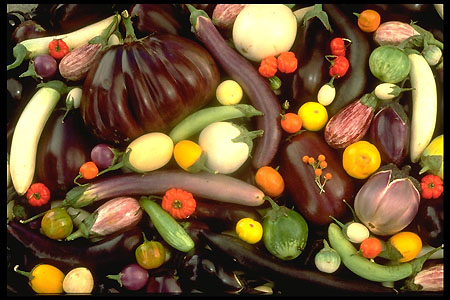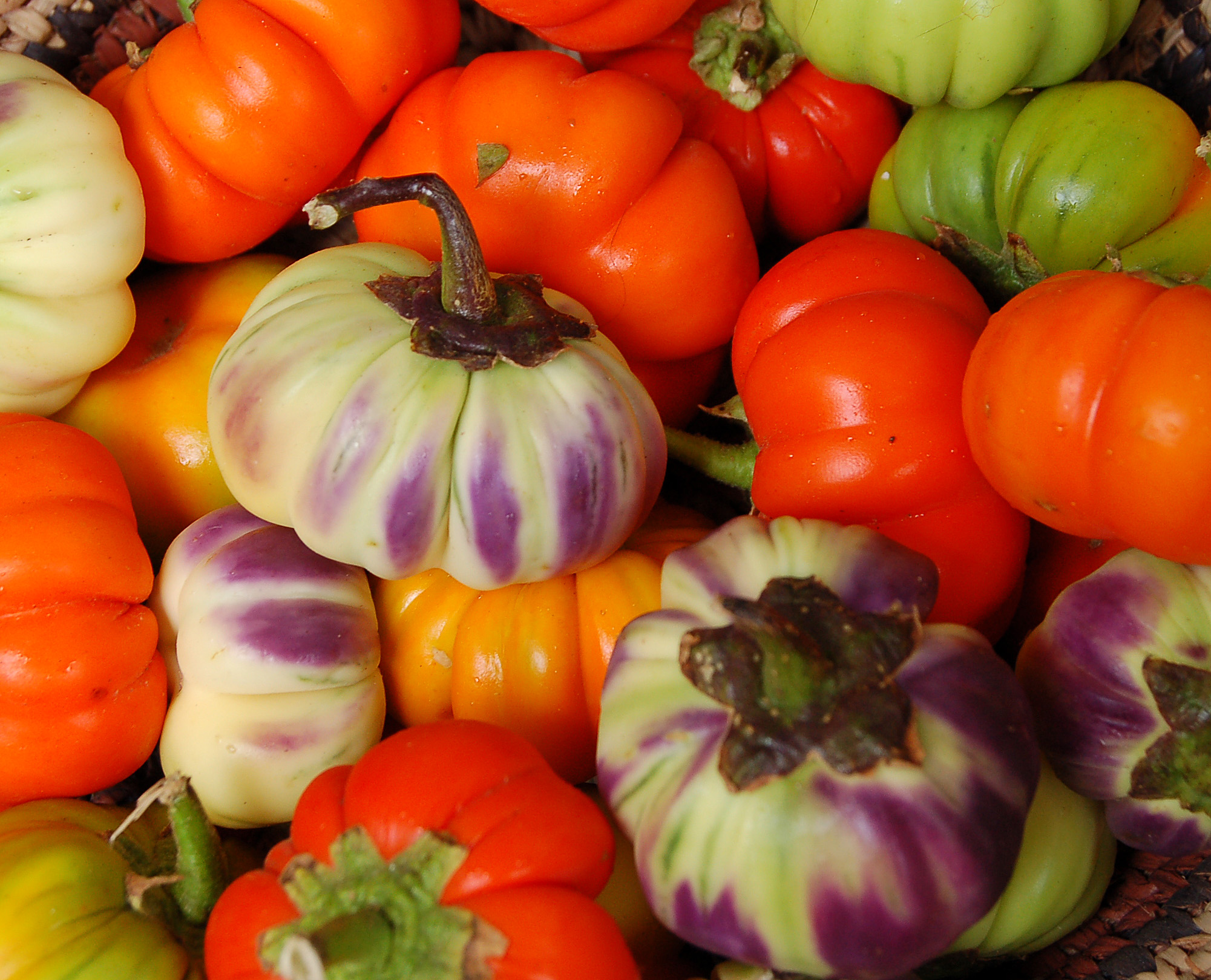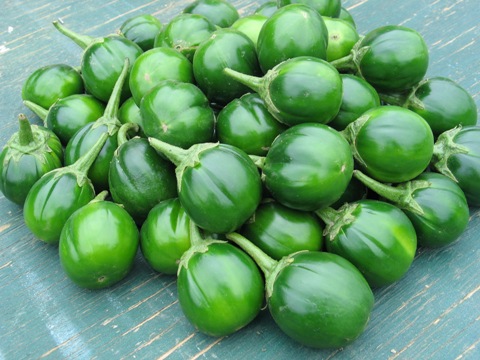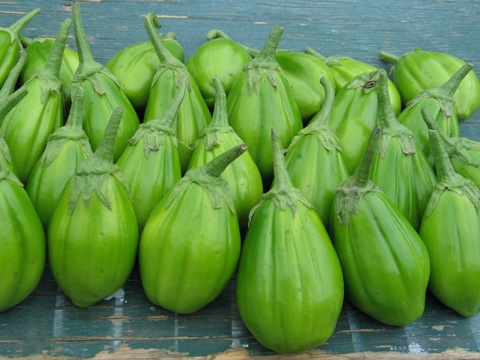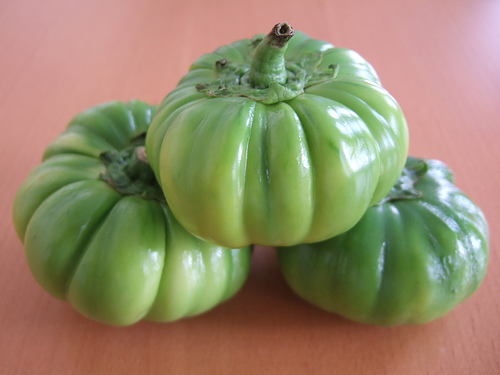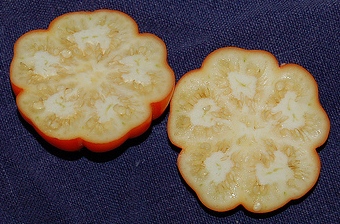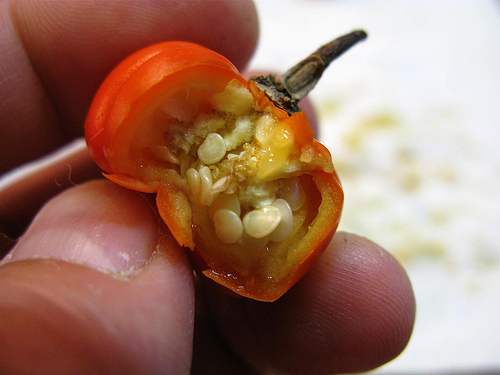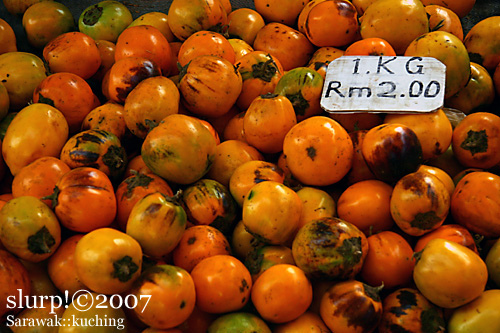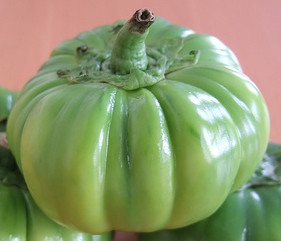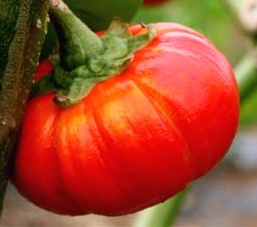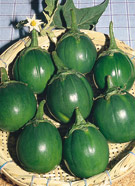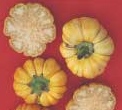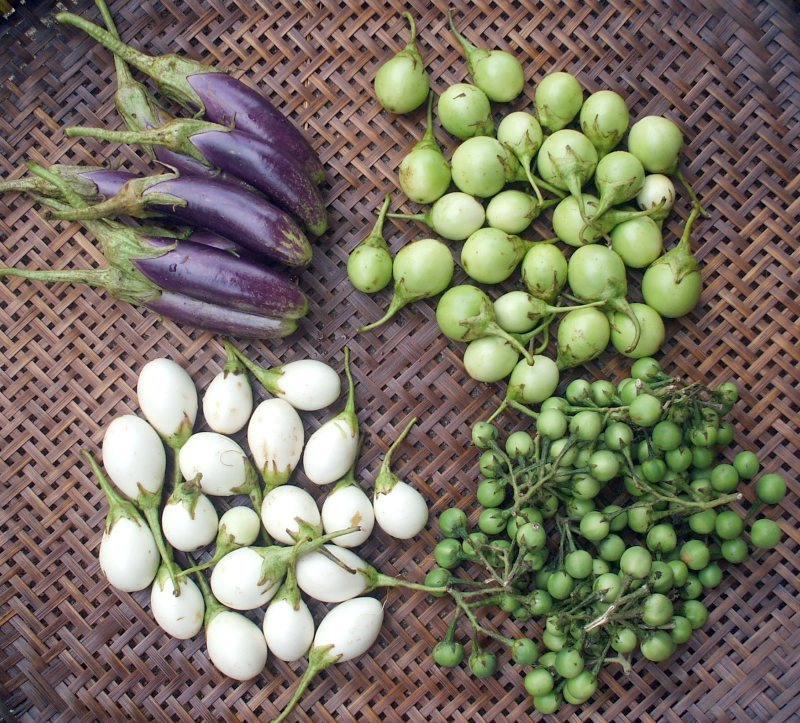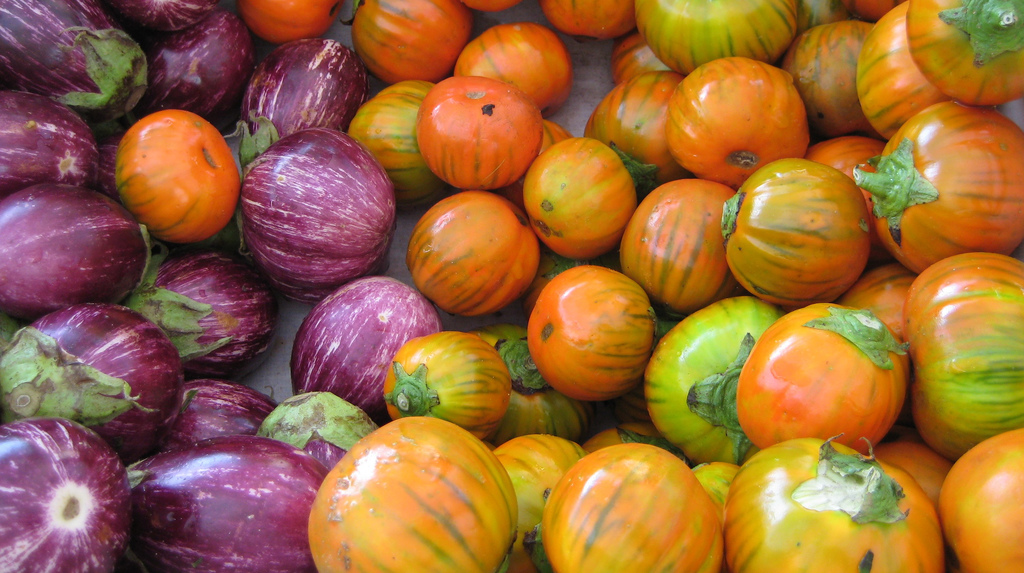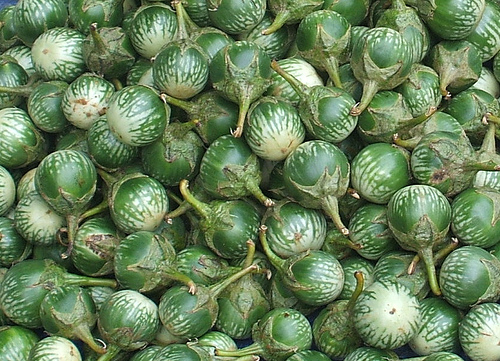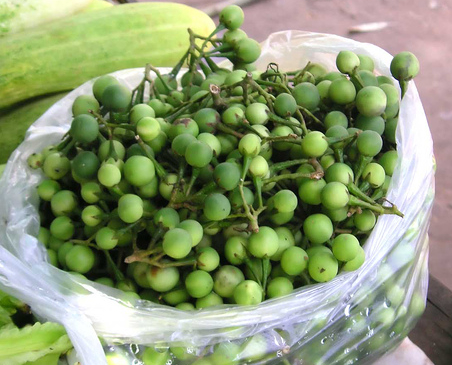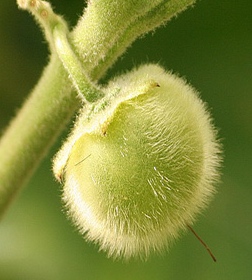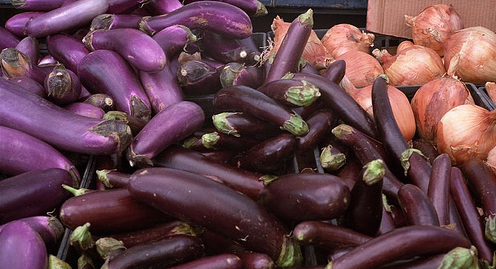Readers please note
While this article is in construction some tiny versions of the eventual photos will be seen in the relevant places, even before we are authorized to publish them. We are in the process of contacting every copyright owner. Should any one feel offended by this process we apologize and will remove any picture that we are specifically told to remove PROMPTLY.
We hope to raise the interest level of all people contacted by having these tiny gifs there as appetizers. We certainly are not in the business of exploiting or taking advantage of anyone. Education is our game and not only does it not pay but it costs us far too much. We find it too hard to stop our compulsive urge to educate. We learn as much in the process as our readers though, so perhaps we are just selfish and trying to satisfy a deep need. Hum! a psych. thesis in perspective.
Know your eggplants - Part 1
African eggplants
The Gilo Group
The
Kumba Group
The Shum Group
The Aculeatum Group
Solanum anguivi Lam.
Solanum macrocarpon L.
Asian eggplants
Solanum melongena L.
Solanum torvum Sw.
Solanum ferox L.
Appendixes
Bilingual lexiques
African
- English
Malay - English
Thai - English
Cultivar descriptions and seed sources tables
African
eggplants
Asian eggplants
To
those of us living with plants it is always a source of amazement that
eggplants
are so little known. Asian and African consumers know theirs well but
are less
familiar with the Asian or Western types. Westerners are equally
ignorant of
the richness found in Asia and Africa. It is even arguable that they
are not
aware of the rich diversity available within the most popular species
Solanum
melongena
L. that
could be available on the market place.
This is understandable because apart from the large purple fruit that everyone knows, very little else is seen in market stalls or on the supermarket shelves. This is not confined to eggplants, it applies to every crop grown and distributed via the market place which, despite the "global village" and the "global market" concepts, remains a market of rather narrow minded traders and consumers. This may be enough to meet the needs of the best known recipes of the Western world such as the Greek “moussaka”, , the French “ratatouille”, the Sicilian “caponata”, the Middle Eastern “baba ghanoush” and “imam bayaldi” But what if one wants to cook the dish from Cameroun “nkwi” or a “แกงเขียวหวานไก่” Gaeng kĭeow wăan gài (Thai green chicken curry) calling for pea eggplants (European green peas not being an option), or even the regional Italian "Fusilli al filetto di melanzana rossa e Caciocavallo Podolico" and "Frittelle di foglie di melanzana rossa" both calling for 'Melanzana Rossa di Rotonda' which is a direct descendant of the African red eggplants?
Some seed companies go to great lengths to make available to their customers a wide range of cultivars (cultivated varieties), but unless people grow the plants, they are not likely to come across some of the most beautiful eggplants available on this planet.
So let us see if we can enthuse some of our readers for some lesser
known
treasures of the eggplant world.
|
|
|
Reproduced with permission from the copyright owner: David Cavagnaro . |
This brilliant display encompasses most of the shapes and colours (but not all) available in the world. The species and mostly the cultivar names will vary greatly in the market place but the basic array will be found. These fruits from open-pollinated varieties were all grown by David during his gardening days with the Seed Savers Exchange USA. Most are still preserved and offered by this organization. It is also possible to find seeds of hybrid forms of all these. We are not fans of hybrids but during a lack of O.P. cultivars they can fulfil a need. They can also be useful if they have been bred to resist specific climatic conditions or some diseases. We do not see the need at all for genetically modified varieties however. Who would, given the broad spectrum covered in this article? It would take the average gardener a lifetime to grow and cook them all in the various ways they are meant to be prepared. The Tomato Growers Seed Supply Company offers probably the widest range of cultivars (mostly the hybrid forms) available in the world from a single source via a beautiful gallery with high quality photos (check the large sizes).
The main difference between the western types of eggplants and the African or Asian is that the first are well and truly domesticated, some would argue too much manipulated and hybridised if not yet genetically manipulated. The Asian and African eggplants are much less domesticated for the most part and are either close to their wild relatives or just plain wild plants such as the pea eggplant from Uganda or the hairy-fruited pea eggplant from Thailand.
African
eggplants
are not so diverse in shapes or even sizes but their glossy-skinned
fruits can
be found striped, multi-coloured, or in many shades of white, cream,
yellow,
green, lime, orange, pink, red, plum, burgundy, lavender, violet,
purple, and
dusky black. The red-fruited varieties are the favorite in most of the
non-African world. All these colours are developing on mature mostly
inedible
fruits. Generally in order to be edible the fruits are better picked at
an
early stage of development, even more so than is the case with western
types of
eggplants. Looking at photos of the
fruits can be misleading. These eggplants are actually
rather small. See the
photo on top of this page where tiny red fruits rest among giants of
different colours, or the measured size for various cultivars in the
table
below. Apart from a source of food, eggplants in general, African
eggplants
in particular, are also used for medicinal purposes in both a
traditional and
modern sense. Targeted diseases are, among others, diabetes,
bronchitis,
asthma, dysuria, dysentery, etc.
Gardening note: I am tempted to say that if you are struggling when growing common eggplants in respect to your climatic conditions forget about attempting to grow tropical African or Asian eggplants. Practical experience however has taught me that given the tumultuous climatic conditions that the world is experiencing, no matter where you live, everything is possible. I did grow successfully some red African eggs on a couple of occasions, and yet I have always struggled most years with some common eggplants cultivars and even some tomato cultivars (the reason why I keep on raving about the Italian Pink Pear which has never really failed me).
|
|
|
|
|
A favourite Brazilian Jilo |
Reproduced from flickr with permission from the copyright owner: Veronica Sullivan
The magnificient colours of mature Kumba |
A favourite Brazilian Jilo |
The best known African eggplants are the miniature pumpkin-shaped so called "African scarlet eggplant" and the Brazilian Jiló.
They both, together with other groups, come under the domesticated species Solanum aethiopicum L., a species with a rich history. The ancestor of this species was the wild Solanum anguivi Lam. Natural evolution and people influences helping, via the semi-domesticated Solanum distichum Schumach & Thonn. found in gardens of Tropical Africa, Solanum aethiopicum L. was born. Following further adaptation to different conditions and responding to various cultural practices, such as selection for leaves as opposed to selection for fruits, the many groups were formed. One group has found its way to Brazil via the slave trade. Today Brazilians enjoy it under the name of Jiló or Jinjilo. It belongs to the Gilo Group, composed mostly of plants with elongated fruits such as those below. Cultivars of a superior quality have yet to be identified and / or developed. One of the bodies leading the search and the research for the ultimate varieties is the African branch of the Asian Vegetable Research and Development Center (AVRDC).
Solanum aethiopicum L. (Gilo Group)
|
|
|
|
|
|
A smooth bi-colored fruit |
A ribbed-red |
A smooth white fruit |
A smooth red fruit |
|
‘Brazilian
Oval Orange’ |
Within the Gilo Group we find ribbed or smooth fruits, either with white, pale-green, dark-green, striped or purple skin. Cultivars on the market are shown in the following table. Some similar looking cultivars such as "Striped Tioga" are listed under Solanum melongena L. in various catalogues but we have not been able to find out the parentage. The two main preferred types in Brazil are:
|
|
|
|
Copyrights Maria Moreira (permission sought
20/04/2009) |
Copyrights Maria Moreira (permission sought
20/04/2009) |
Solanum aethiopicum L. (Kumba Group)
|
|
|
Reproduced from flickr with permission from the copyright owner: cia_b
Green fruits ready for picking before the bitter taste develops. |
Plants of this group can be found in catalogues under the synonyms "Red African eggplant", "Orange African eggplant", "Scarlet African eggplant", and even "Mini pumpkin tree". It is often treated as an ornamental in the West because it is strikingly beautiful but also because from a culinary perspective it does not meet the taste of every westerner. Much of the negative feelings towards it are based on ignorance of the basic preparation. The fruits are best picked green, before they start colouring and developing seeds - a general rule applying to all eggplants.
|
|
|
|
Reproduced from flickr with permission from the copyright owner: Veronica Sullivan Inside a maturing fruit |
Reproduced from flickr with permission from the copyright owner: Joel Ignacio Inside an almost mature fruit showing seeds forming. The finger tips give an indication of the size of Kumba |
According to the trade there are some sweet cultivars and some bitter cultivars, although there is no unanimous opinion on the subject. In fact many cultivars can be both either sweet or bitter, depending on the growing conditions and the picking time. There is a cultivar called 'Black Stream' with black stems and red or orange fruits which is grown as an ornamental in France.
Some edible cultivars are grown for their leaves, others for their fruits, and yet others for both (see descriptions in table below).
Unlike the pretty fruits in the photo above many edible African eggplants are not so attractive and look more like the fruits below:
|
|
|
Reproduced
with permission from the copyright owner Technisem
Seeds |
The cultivars not available from the sources mentioned in the table below can possibly be tracked down via the African Seed Trade Association.
Solanum aethiopicum L. (Shum Group)
The cultivars within this group are grown for their leaves. The little bite-size fruits although edible when ripe are often neglected. We could not find any cultivar from this group. Perhaps some of those listed under Solanum macrocarpon L. belong here ?
Solanum aethiopicum L. (Aculeatum Group)
This is a group of plants with fruits twice as large as those of the Shum type but totally neglected from the culinary point of view. One wonders if their spiny leaves and stems are a consequence of the neglect or the cause of it. The size of their fruits may make them confusable with those of those listed under Solanum macrocarpon L. They can be grown as ornamentals or used as root stock for tomatoes and eggplants. ‘Iizuka’ has been selected in Japan for this purpose.
Solanum anguivi Lam.
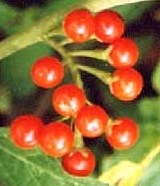
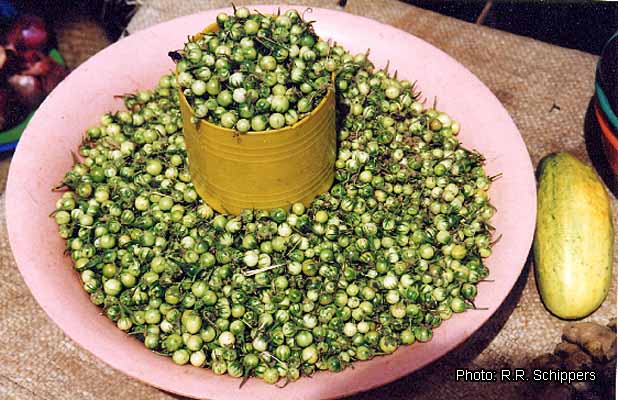  |
| Reproduced from PROTA article
with
permission from the copyright owner: Rudy
R. Schippers Green Uganda Pea eggplant at edible (but bitter) stage. Grapes of ripe red berries (edible to birds only). |
As a semi-domesticated species it offers a great variation in the plants, flowers and fruits numbers, sizes, colours etc. Worth noting is the Uganda Pea eggplant. The bitter pea-size green fruits are eaten in various ways fresh or dried. In Cameroun they are a vital ingredient of a dish called “nkwi”. They are either picked from the wild plants or grown / tolerated on farms and gardens. In Africa or for African people elsewhere having access to them they are the equivalent to the Asian pea eggplant Solanum torvum L.
'Gnangnan' (from Ivory coast) is a "cultivar" (une forme spontanée!) but most cooks think of it as a "small eggplant". 'Damsah' (Damesah) is possibly a hybrid between Solanum aethiopicum L. (Gilo group) and Solanum anguivi Lam. from the Burkina Faso (formerly called Upper Volta). It bears grapes of small round fruits white to red in colour. Another hybrid of similar parentage is called 'Klongbo' but little is known about it.
|
|
|
< http://www.bgard.science.ru.nl/eggnetdb2/files/diafiles-8610-MM_10130a.jpg
>
'Damsah' . Photo credits ECPGR. (permission sought 20/04/2009) |
Propagation of the African eggplants.
From
the seed saver perspective the first thing to keep in mind is that
these plants
are tropical. The second is that all the plants from all species named
above can
cross with each other, produce fertile seeds and therefore in the right
conditions can become weeds. Similarly in non-tropical settings it will
be
equally important to avoid cross-pollination by isolating in the usual
manners:
distance, netting, bagging, spaced flowering if possible etc. This is
not to
avoid propagating weeds but to conserve cultivars true to type as much
as
possible.
Solanum macrocarpon L.
|
|
| Reproduced
from flickr
with permission from the copyright owner: Slurp |
This is also known
as the
"African eggplant", sometimes as
"African macrocarpon". A better hybridised name is "Gboma
eggplant" based on its correct African name Gboma.
Gboma (a village from Liberia - West Africa) has
given its name to many
cultivated forms of S. aethiopicum and S. macrocarpon eggplants in West
Africa
and in many coastal countries. It is mostly recognized in relation to
S.
macrocarpon however. Indeed because many cultivars take their names
from
village names there is even a cultivar called 'Gboma' foumd in Togo but
this being the
common African name for many eggplant types it is really a particularly
misleading
name for
a cultivar.
One could say of this species also that it is semi-domesticated. As such it still has great variations in its growth habit, fruit sizes etc. It is one of the semi-wild species showing the greatest potential for hybridising. The main reason is that its great diversity could be developed in many directions. The second is that its natural resistance to bugs and diseases could improve weaker varieties of the main domesticated species Solanum aethiopicum L. and mostly Solanum melongena L. by crossbreeding.
When cultivated, varieties are selected for their fruits, usually the thin skinned are preferred, or their leaves. Both fruits and leaves are bitter and most need to be consumed locally. This can only be an advantage from the ecological viewpoint - no storage - no transport to the other side of the world. If the rest of the world wants it, it has to grow it or does it? Despite the ordinary quality of the crop some enterprising countries have managed to develop some thick-skinned fruits that will store and travel. Senegal and Ouganda export to France (the Château-Rouge market and surrounding shops in the heart of Paris would be a first port of call), San Domingo and Surinam export to the USA. Not a promotion of the best that Africa has to offer but a back door entry for planting material for seed savers and enterprising horticulturists.
There are 4
groups recognized within this species (Bukenya
and Carasco - 1994). We have slotted some cultivars in some of those
groups (see table below).
Solanum macrocarpon Poir. (Mukono Group)
Named after the Town
and cultivar Mukono.
Solanum macrocarpon Poir. (Nabingo Group)
Named after the
Town and cultivar Nabingo.
Solanum macrocarpon Poir. (Semi wild Group)
Synonym: Solanum dasyphyllum Thonn. ex Schum.Solanum
macrocarpon
Poir. (Uganda
Group)
One cultivar called 'Gbokouman', from The Southern Ivory Coast, is reported within this species, but little is known about it.
Other
cultivar with unknown / unclear taxonomy:
|
‘Cookstown Orange’ |
Green fruits rather bitter with
dark green stripes when young and edible. Green-orange with faint
dark-green stripes when ripe. Possibly a Solanum
aethiopicum L. (Aculeatum Group) or a Solanum macrocarpon L. cultivar.
70 days. Available : Sand Hill Preservation Center - Canada. |
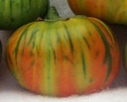 |
African cultivars on the world market
This is not a print publication but a live interactive guide. Comments are very welcome
send mail to m.porcher@unimelb.edu.au
|
Botanical identification (proposed) |
Cultivar name / Vernacular name |
Descriptive info. (various sources) |
Photo of cultivar or type if available |
|
|
|
|
|
|
Solanum macrocarpon L. |
‘Akwaseho’ |
Fruits and leaves are consumed. From Ghana. |
|
|
Solanum aethiopicum L. (Gilo Group) |
‘Brazilian Oval Orange’ |
Available : Baker Creek Heirloom Seeds |
|
|
Solanum macrocarpon L. |
‘Bui’ |
Fruits only are consumed. From Ghana. |
|
|
Solanum aethiopicum L. (Gilo Group) |
‘Comprido Cachoeira’ |
Elongated fruits vary from 20 to 50g per fruit. |
|
|
Solanum aethiopicum L. (Gilo Group) |
‘Comprido Grande Rio ’ |
8 -10 cm thick fruits 80 - 100 g. Elongated form of Verde Claro from Minas Gerais, Rio de Janeiro. Available : SAKATA Seed Sudamerica Ltda. |
|
|
Solanum aethiopicum L. (Gilo Group) |
‘Comprido verde claro ’ aka ‘ Comridio verde ’ (misspelt) |
Tear-drop light green fruit about 1/4 of the size of a medium size eggplant. From Minas Gerais, Rio de Janeiro & Espirito Santo. Available : Possibly from Johnny's Selected Seeds. |
|
|
Solanum aethiopicum L. (Gilo Group) x Solanum anguivi Lam. |
‘Damsah’ |
Pea size fruits. From Burkina Faso (Upper Volta). |
|
|
Solanum aethiopicum L. (Kumba Group) |
‘Dwomo’ |
Egg-shaped fruits. From Ghana. |
|
|
Solanum macrocarpon L. |
‘Gbogname’ |
Ancient vegetable from Togo, West Africa. Its young green leaves are cooked but the green and yellow bitter fruits (7 to 8 cm in diameter) are ignored. |
|
|
Solanum macrocarpon L. |
‘Gboma’ |
Fruits and leaves are consumed. From Ghana. |
|
|
Solanum aethiopicum L. (Kumba Group) |
‘Goyo Kumba’ |
Available : Kokopelli. |
|
|
Solanum macrocarpon L. |
‘Igbagba’
|
From Nigeria. |
|
|
Solanum aethiopicum L. (Kumba Group) |
‘Jaxatu Soxna’ |
|
|
|
Solanum macrocarpon L. |
‘Kade’ |
Fruits and leaves are consumed. From Ghana. |
|
|
Solanum macrocarpon L. |
‘Mankessim’ |
Fruits and leaves are consumed. From Ghana. |
|
|
Solanum aethiopicum L. (? Group) |
‘Manyire Green’ |
Round, green ripening to red fruits. From East Africa. |
|
|
Solanum aethiopicum L. (Aculeatum Group) Synonym : Solanum integrifolium Poiret |
‘Melanzana Rossa di Rotonda’ aka ‘Merlingiana a Pummadora’ aka ‘Italian Orange’ |
Brought from Africa and grown since the late1800's in Rotonda - Italy and claimed with justification as an Italian Heirloom. Available : Italian private growers. |
|
|
Solanum aethiopicum L. (Gilo Group) |
‘Morro Grande Verde-Escuro’ aka 'Dark Green Morro Grande’ |
Dark-green larger round or oblong fruits 6 - 7 cm diameter, 80 - 100 g . From São Paulo. Available : ISLA, SAKATA Seed Sudamerica Ltda. |
|
|
Solanum aethiopicum L. (Gilo Group) |
‘Morro Redondo’ |
Bitter round dark-green fruits about 1/4 of the size of a medium size eggplant. From São Paulo. Available : Possibly from Johnny's Selected Seeds. |
|
|
Solanum macrocarpon L. (Mukono Group) |
‘Mukono’ |
|
|
|
Solanum aethiopicum L. (Kumba Group) |
‘N’Drowa Issia’ |
Sweet fruits 5 cm diameter 70 - 80 g. From Ivory Coast. Available : Graines Baumaux |
|
|
Solanum aethiopicum L. (Kumba Group) |
‘N’Drowa’ |
Non bitter yellowish- green slightly ribbed fruits on very vigorous plants. 55 - 60 days. Available : Technisem |
|
|
Solanum aethiopicum L. (Kumba Group) |
‘N’Galam’ |
Slightly bitter Light-green to white fruits, variable in size according to conditions.120-180 g. 65 - 75 days. Available : Technisem |
|
|
Solanum aethiopicum L. (Kumba Group) |
‘N’Goyo’ |
Bitter dark-green fruits, variable in size according to conditions. 70-120 g. 60 80 days. Available : Technisem,
Graines Baumaux |

|
|
Solanum macrocarpon L. (Nabingo Group) |
‘Nabingo’ |
|
|
|
Solanum aethiopicum L. (Gilo Group) |
‘Português ’ |
8 -10 cm thick fruits 80 - 100 g. From Minas Gerais, Rio de Janeiro. Available : SAKATA Seed Sudamerica Ltda. |
Similar to 'Comprido Verde Claro' |
|
Solanum aethiopicum L. (Kumba Group) |
‘Red China’ aka ‘Scarlet Chinese’ aka ‘Rouge de Chine’ |
Fruits 0.75 to 1 inches long by 2
to 2.5 inches wide.
Mildly bitter at orange stage, too bitter for most tastes when red.
Spiny plant. 50days. |
|
|
Solanum aethiopicum L. (Gilo Group) |
‘Red Egg’ |
Available : Graines Baumaux |
|
|
Solanum aethiopicum L. (Kumba Group) |
‘Red Ruffled’ aka ‘Hmong Red’ |
2 inches fruits |
|
|
Solanum aethiopicum L. (? Group) |
‘Red Skin’ |
Available : Eden Seeds |
|
|
Solanum macrocarpon L. |
‘Sarpeiman’ |
Fruits only are consumed. From Ghana. |
|
|
Solanum aethiopicum L. (Kumba Group) |
‘Small Ruffled Red’ |
Small, deeply creased fruits, about 5 cm in diameter, with orange-red skin, 2" fruits are borne in clusters on 20" plants. Fruits are bitter, but used extensively in Asian cuisine. Available : Seed Savers Exchange. |
|
|
Solanum aethiopicum L. (Gilo Group) |
‘Sodefel’ |
A cultivar from the Ivory Coast. |
|
|
Solanum aethiopicum L. (Gilo Group) |
‘Striped Nigerian’ |
Fruits are described as oval-shaped striped with green and red. From Nigeria. |
|
|
Solanum aethiopicum L. (Kumba Group) |
‘Super N'Drowa’ |
Sweet ivory-white round fruits on very vigorous plants. 55 - 60 days. Available : Technisem |
|
|
Solanum aethiopicum L. (Gilo Group) |
‘Sweet African Egg’ aka ‘Sweet African Orange’ |
4 inches (10 cm) oval or round fruits maturing from white to shiny orange-red. on plants 2.5 feet (76 cm) tall.90 days. Available : Terroir Seeds LLC. |
|
|
Solanum aethiopicum L. (? Group) |
‘Sweet Red ’ aka ‘Sweet Orange’ |
Small, attractive fruits, about 2.5 cm in diameter, green skinned with dark-green stripes, turning red with dark-red stripes at maturity, Available : no known source. |
Seems to have disappeared. We could no longer find it on the market. |
|
Solanum aethiopicum L. (? Group) |
‘Tengeru White ’ |
Round, half green, half white fruits. |
|
|
Solanum aethiopicum L. (Gilo Group) |
‘Tinguá’ aka ‘Tingua Verde Claro’ aka ‘Jiló Tinguá Verde Claro’ |
Plant is heavy yielder. Fruits consumed green, mature to orange and red. From Minas Gerais, Rio de Janeiro Available : Baker Creek
Heirloom Seeds, Kokopelli, ISLA |
|
|
Solanum aethiopicum L. (Aculeatum Group) Synonym : Solanum integrifolium Poiret |
‘Turkish Orange’ aka ‘Italian Orange de Turquie’ aka ‘Italian Orange’ Probably not a true synonym |
Orange spherical fruits, 6 cm in diameter to tennis-ball size (2.5 to 3 inches). "Excellent sweet taste" to "Bitter taste" depending on picking time. 80 days to 90 days. 4 foot plants bear 15-25 fruits per plant. Available : Reimer Seeds, Baker Creek Heirloom Seeds, Seeds of Change, Chiltern Seeds, Southern Exposure Seed Exchange, Diggers Seeds Aust., Kokopelli. |
|
|
Solanum anguivi Lam.
|
‘Uganda Pea’ |
Tiny pea size white to green fruits. |
|
Note on the following companies.
A number of those are part of complex corporate structures and are difficult to contact directly. The main address that we give below is a starting point. We are not sponsored by any of those companies nor do we receive any favour from them apart from the odd catalogue photo. It would be nice to be able to link directly to a gallery or a photo or a description but this is sometimes impossible and practice has taught us that these links never last long anyway because online catalogues are updated every 6 or 12 months. The seed sources likely to carry Open Pollinated / bio ag. friendly cultivars are marked O.P., Others are more likely to carry some hybrids but they may have also some organic sections such as Graines Baumaux.
Australian Free Seed Ring .O.P.
Baker Creek Heirloom Seeds .O.P.
Cross Country Nurseries (seedlings).
Diggers Seeds Aust. O.P.
Johnny's Selected Seeds. O.P.
Kokopelli
.O.P.
Long Island Seed
Project .O.P.
Sand Hill Preservation Center -
Canada.
Seed Exchange . O.P.
Seed Savers Exchange .O.P.
Southern Exposure Seed Exchange .O.P.
Terroir Seeds LLC. otherwise known as Underwood Gardens.
Disagreements on botanical names
'Tingua Verde Claro' is considered by Kokopelli as a Solanum aethiopicum L. (Aculeatum Group). We think it is a Jilo so have placed it in that group. They also list 'Rouge de Chine', which we think is a synonym of 'Red China', as a Solanum aethiopicum L. (Aculeatum Group). We tend to think that it is rather in the Kumba Group.
'Turkish Orange' is listed as Solanum melongena L. and described as "From India, developed in Spain in 16th century" in some catalogues. Others list it as Solanum integrifolium Poir. We agree with them but we prefer to use the preferred name Solanum aethiopicum L. (Aculeatum Group). We have difficulties with placing the Italian version 'Rossa di Rotonda' of this variety under this botanical name as well but we have done it nevertheless for now. We would greatly appreciate feedback on these little disagreements.
Disclaimer
We have done our best trying to identify every cultivar mentioned. If we have made mistakes please tell us. We have not discriminated between so called organic source of seeds and others in order to offer the broad spectrum of what is available in the world. Again if me missed something please tell us, we will update this table promptly. Send mail to m.porcher@unimelb.edu.au
|
|
|
Reproduced
from flickr with permission from the
copyright owner: Dorami
Chan The basic sizes in Asian
eggplants |
Asian eggplants have representatives in these better known species: Solanum melongena L. , Solanum torvum Sw. , Solanum ferox L. Other mostly wild species are used both as sources of food and medicinal plants.
Solanum melongena L.
There is an abundance of cultivars of all sizes, shapes and colours among the Asian eggplants, far greater than among Western types. The queen of the Asian is Ping Tung by all accounts. The most productive and the most spectacular fruit. The demoiselles d' honneur would have to be Asian Bride and Thai Long Green, for the beauty of their fruit and in the case of Thai Long Green the health of its plant. Here are a few examples to make your salivate:
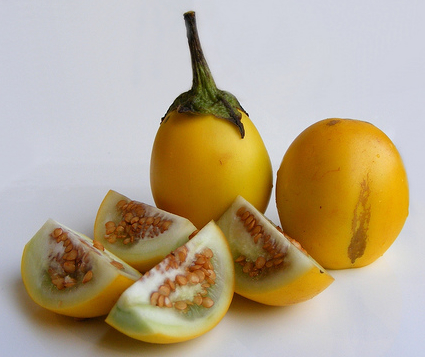 |
| Reproduced
from flickr with permission from the
copyright owner: Kok Robin 'Thai Yellow Egg' aka 'Thai Round Yellow' aka 'Golden Egg' (actually white at edible stage) |
|
|
|
|
|
|
|
|
|
|
|
Reproduced
from flickr with permission from the
copyright owner: Garandee |
|
|
|
Reproduced
from flickr with
permission
from the copyright owner: see. wolf Asian round purple (S. melongena) and Orange eggplants (S. macrocarpon) |
Solanum torvum Sw.
Curiously this Central / South American species, common garden plant in the Caribbean, is better known in Asia, and here in Australia is always referred to as an Asian vegetable or "Thai pea eggplant". This is due to the efforts of the Thai horticultural community which has developed and promoted locally as well as abroad some improved cultivars. Elsewhere it tends to be considered as a weed even as a noxious weed due to its ability to self seed. In marketing terms, in some parts of Africa it is becoming a rival to the Uganda pea eggplant. Health authorities warned that if it became too popular and were eaten in large quantities it could lead to health problems. That could probably be said of most wild, semi-wild and even some domesticated varieties of Solanum, including the humble potato, given specific circumstances such as a greening of the tubers. The main offender being the poisonous solanine content of these plants. Certainly livestock have been poisoned by eating some of these plants.
Generally speaking clusters of immature green fruits rather than individual fruits are picked when they reach pea- size or cherry- size, depending on cultivars. Some catalogues offer varieties without prickles, some sweet-fruited cultivars and seeds of varieties suitable for rootstock production.
One probably would have to look through the hybrids for really improved large and / or sweet fruits and for prickles plants. The East-West Seed Group < http://www.eastwestseed.com/product_family.asp?comid=1 > carry some in stock. 'Kermit' (photo below) is the best known of this type although it is always advertised as a Solanum melongena L. cultivar. Perhaps this is because it is a hybrid having S. melongena parentage. I would welcome advice on this.
|
|
|
|
|
Reproduced
from flickr with permission
from the copyright owner: Dorami
Chan
|
Photo credits: East-West Seed International
|
Reproduced from flickr with permission from the copyright owner: Clay Irving The typical pea eggplant Solanum torvum Sw. |
Gardening note: Rudy R. Schippers in her article on Solanum torvum Sw. mentions that the seeds need exposure to sunlight in order to germinate.
|
|
|
|
Solanum ferox L.
This is a truly wild species with its armada of prickles. It produces the Wild pea eggplants of Thailand as opposed to the domesticated types of the preceding species. The hairy fruits are picked young and the fuzz removed by brushing. When they turn yellow they have passed their edible stage. It is known as the "Hairy-fruited eggplant", "Malaysian sunplant", "Yellow-fruited nightshade" etc.
Some semi-domesticated forms are beginning to be reported in East Asia, even some without prickles.
There are five to seven groups of cultivars in this species but we will
mention
only
two because the others are still obscure in terms of horticulture.
Solanum ferox L. (Domesticum Group)
This group seems to be composed mainly of plants from Thailand.We haven't found any cultivar yet.
Solanum ferox L. (Sinkade Group)
This group seems to be composed mainly of plants from Burma (now called Myanmar). As one would expect there is a cultivar called 'Sinkade' with larger cherry-sized fruits.
Some
of the widest ranges of Asian eggplants are to be found in the
following
galleries:
Evergreen Seeds' site, Cross Country Nurseries (seedlings). Among their Asian eggplants is a cultivar called 'Red China' (listed as Solanum melongena L.) looking very much like the African 'Kumba', and Baker Creek Heirloom Seeds . 'Red China' is also listed here.
Appendixes
The vernacular / common names below are most unreliable. They are given here to give hints on "what it could be" but not "what it is". The purpose of the MMPND is actually to sort the valid names from the others, a process that will go on until 2020 and most likely beyond.
A mini lexique of African names
Djakattou = French rendering of Western African name for African eggplant (Solanaceous aethiopicum L. (Kumba Group))
Djakhattou = French rendering of Western African name for African eggplant (Solanaceous aethiopicum L. (Kumba Group))
Enjagi (Uganda) = Bitter berries ((Solanaceous aethiopicum L. (Gilo Group))
Entula enganda (Uganda) = Bitter berries ((Solanaceous aethiopicum L. (Gilo Group))
Entura (Uganda) = Bitter berries ((Solanaceous aethiopicum L. (Gilo Group))
Gboma = applied to either Solanaceous aethiopicum L. or Solanaceous macrocarpon Poir.
Jagi (Uganda) = Bitter berries ((Solanaceous aethiopicum L. (Gilo Group))
Jakhatou = French rendering of Western African name for African eggplant (Solanaceous aethiopicum L. (Kumba Group))
Jagatú tunga = Portuguese rendering of African name for African eggplant (Solanaceous aethiopicum L.)
Nakasuga (Uganda) = Leaves of scarlet eggplant (Solanaceous aethiopicum L.)
Nakati (Uganda) = Leaves of scarlet eggplant (Solanaceous aethiopicum L.)
Nakati nume y'akyalo (Uganda) = (Solanaceous macrocarpon Poir.)
Ngogwe (Swahili) = African eggplant (Solanaceous aethiopicum L.)
Nyanya chungu (Swahili) = African eggplant (Solanaceous aethiopicum L.)
Vergans (Uganda) = (Solanaceous macrocarpon Poir.)
Suggestions, corrections, additions welcome.
A mini lexique of Malay names
Tarong pasai (Brunei) = Solanum ferox L.(also applied to Solanum lasiocarpum Dunal - syn of S. ferox auct. non L.)
Terung asam = Sour eggplant (Solanum melongena L. and Solanum ferox L.)
Terung Bulat = Round Asian eggplant (Solanum melongena L.)
Terong cepoka. = Solanum torvum Sw.
Terung dayak = Solanum ferox L.
Terong engkol = Solanum macrocarpon
Terong gayung (Sundanese) = Solanum macrocarpon
Terong hijau = Green eggplant (Solanum melongena L.)
Terung hitam = Dark-purple eggplant (Solanum melongena L.)
Terong iban = Solanum ferox L.
Terong kelapa = Solanum macrocarpon
Terung Panjang = Long Chinese eggplant (Solanum melongena L.)
Terung Pendek = Japanese egglant
Terong perat = Solanum ferox L.(also applied to Solanum americanum L.)
Terong pipit (Sumatra) = Solanum torvum Sw.(also applied to S. violaceum)
Terung putih = Small white eggplant
Terong rapoh = Solanum macrocarpon
Terong rembang = Solanum macrocarpon
Terong santan = Solanum macrocarpon
Terung Siam = Thai eggplant, Kermit eggplant (Solanum melongena L.)
Terung ungu = Violet eggplant.
Suggestions, corrections, additions welcome.
A not so mini lexique of Thai names
Including other species fron the genus Solanum. These may not cross-fertilise with the eggplants but they may well be susceptible to the same diseases. For example the tobacco virus can be transmitted on to eggplants by smoking gardeners.
มะปู่ Ma bpoo = Solanum ferox L. (Sinkade Group )
มะแขว้ง Ma kae -> Solanum torvum Sw.
มะแขว้งขม Ma kae kom -> Solanum sanitwongsei Craib (bitter)
มะแขว้งขม Ma kae kom -> Solanum violaceum Ortega (bitter)
มะแขว้งเคือ Ma kae keuang -> Solanum trilobatum L.
มะเขือ Ma khuea -> Solanum melongena L.
มะเขือเปราะ Ma khuea bpror -> Solanum aculeatissimum Jacq.
มะเขือเปราะ Ma khuea bpror -> Solanum melongena L. (round Thai eggplant, small round brinjal)
มะเขือเปราะ Ma khuea bpror -> Solanum xanthocarpum Schrader et Wendl.
มะเขือต้น Ma khuea dton -> Solanum wrightii Benth.
มะเขือขาว Ma khuea khao (Má kĕua kăao) -> Solanum melongena L. (Large egg plant).
มะเขือขื่น Ma khuea kheun -> Solanum melongena L. ? small round brinjal also aculeatissimum ? (bitter)
มะเขือขื่น Ma khuea kheun (Má kĕua kèun) -> Solanum xanthocarpum Schrader et Wendl. (Yellow-berried nightshade) (bitter)
มะเขือม่วง Ma khuea muang -> Solanum melongena L. (purple fruit)
มะเขือม่วงเล็ก Ma khuea muang lek -> Solanum melongena L. (Small Purple Eggplant)
มะเขือหนาม Ma khuea naam -> Solanum aculeatissimum Jacq.
มะเขือพวง Ma khuea phuang -> Solanum torvum Sw. (Brinjal, pea-eggplant)
มะเขือส้ม Ma khuea som -> Lycepersicum esculentum Mill. (Currant tomato)
มะเขือเทศ Ma khuea tet (Má kĕua têt) -> Lycepersicum esculentum Mill.
มะเขือหวาน Ma khuea waan -> Solanum muricatum Ait.
มะเขือยาว Ma khuea yao (Ma khuea yaao) -> Solanum melongena L. (long thin fruit)
มะอึก Ma ûk -> Solanum ferox L.
มะแว้ง Ma waeng -> Solanum violaceum Ortega (Solanum indicum sensu C.B. Clarke, Solanum indicum auct. non L.)
มะแว้ง Ma waeng -> Solanum indicum L. Possibly a mistake - non L.
มะแว้ง Ma waeng -> Solanum trilobatum L.
มะแว้งต้น Ma waeng dton -> Solanum sanitwongsei Craib
มะแว้งเครือ Ma waeng khruea -> Solanum trilobatum L.
มะแว้งนก Ma waeng nok -> Solanum americanum Mill.
มันฝรั่ง Man farang -> Solanum tuberosum L.
Suggestions, corrections, additions welcome.
Finally ...
Among the millions of photos that could not make it in this article here is a list of URL for you to drool over on sleepless night.
|
|
|
|
|
Reproduced
from flickr
with permission
from the copyright owner: Overthemoon
|
Reproduced
from flickr with permission from the
copyright owner: Cornelis Verwaal
|
Reproduced
from flickr
with permission
from the copyright owner: Louise Purple, white-striped by Louise
|
Acknowledgements:
I wish to acknowledge the kind cooperation of many colleagues mentioned
throughout this article and mostly all my flickr contacts who have
provided useful comments and many of those beautiful photos. Thanks to
all.
References:
***** This is a sign of a great reference.
Agnieszka Sękara, Stanisław Cebula, Edward Kunicki, 2007, Cultivated eggplants – origin, breeding objectives and genetic resources, a review. FOLIA HORTICULTURAE Ann. 19/1, 2007, 97-114. Department of Vegetable Crops Agricultural University in Kraków, Poland. < http://www.ptno.ogr.ar.krakow.pl/Pobrania/download.php?action=save&id=197& cat=fh19012007 >. PDF file. *****
AllPenang.com, 2007, Multilingual List of Vegetables available in the Penang Wet Market. < http://malaysian-cuisine.com/touristinfo/wet_market-vegetables.htm >.
Bukenya, Z. R. and J. B. Hall. 1987. Six cultivars of Solanum macrocarpon (Solanaceae) in Ghana. Euphytica 17(1): 91-5.
College of Agriculture and Life Sciences - Cornell University. Interesting evaluations of most eggplants cultivars on the market by subscribers. < http://vegvariety.cce.cornell.edu/mainSearch/showAll.php?ID=23&sortBy=overallrating&order=DESC&searchIn=1 >.
Elizabeth Byanjeru Rubaihayo, Conservation and use of traditional vegetables in Uganda < http://www.bioversityinternational.org/publications/Web_version/500/ch15.htm >.
Ethiopian Plant Names < http://www.ethiopic.com/aplants.htm >.
Guillet Dominique, 2007, Semences de Kokopelli, 7th Edition. Edition La Voix des Semences. pp.452 - 463.
International ECPGR Eggplant Database. Botanical and Experimental Garden, Radboud University Nijmegen, The Netherlands. EGGNET (EGGplant genetic resources NETwork), a project funded by the European Union. The project is coordinated by Ms. Marie-Christine Daunay, Unité de génétique & amélioration des fruits et légumes, INRA, Montfavet, France. < http://www.bgard.science.ru.nl/eggnetdb2/ >.
Medicinal
Plants of Myanmar. <
http://www.tuninst.net/MyanMedPlants/TIL/famS/Solanaceae.htm#Solanum-spp
>.
M.M.P.N.D. For all nomenclatural details we refer you to our page on Eggplants.
Natural History Museum. Solanaceae Source - A global taxonomic resource for the nightshade family. < http://www.nhm.ac.uk/research-curation/research/projects/solanaceaesource/taxonomy/list.jsp >.
PROTA < http://database.prota.org/ >.
The following reference pages from PROTA contain far more colour photos and details on all aspects of the species treated above. We have considered the information on these pages as our main references because they contain far more details than any other source. *****
Bukenya-Ziraba, R., 2004. Solanum anguivi Lam. [Internet] Record from Protabase. Grubben, G.J.H. & Denton, O.A. (Editors). PROTA (Plant Resources of Tropical Africa / Ressources végétales de l’Afrique tropicale), Wageningen, Netherlands. < http://database.prota.org/search.htm>. Accessed 18 April 2009.
Lester, R.N. & Seck, A., 2004. Solanum aethiopicum L. [Internet] Record from Protabase. Grubben, G.J.H. & Denton, O.A. (Editors). PROTA (Plant Resources of Tropical Africa / Ressources végétales de l’Afrique tropicale), Wageningen, Netherlands. < http://database.prota.org/search.htm>. Accessed 18 April 2009.
Bukenya-Ziraba, R. & Bonsu, K.O., 2004. Solanum macrocarpon L. [Internet] Record from Protabase. Grubben, G.J.H. & Denton, O.A. (Editors). PROTA (Plant Resources of Tropical Africa / Ressources végétales de l’Afrique tropicale), Wageningen, Netherlands. < http://database.prota.org/search.htm>. Accessed 18 April 2009.
Schippers, R.R., 2004. Solanum torvum Sw. [Internet] Record from Protabase. Grubben, G.J.H. & Denton, O.A. (Editors). PROTA (Plant Resources of Tropical Africa / Ressources végétales de l’Afrique tropicale), Wageningen, Netherlands. < http://database.prota.org/search.htm>. Accessed 18 April 2009.
Seeds / Plants sources / Useful contacts
Technisem
7 avenue du Garigliano
ZAC des Gâtines
91601 Savigny sur Orge cedex
France
Tel : +33 1 69 96 03 42
Fax : +33 1 69 96 86 01
E-mail : technisem@technisem.com
Technisem Asia Pty Ltd
Stephane Gorin, General Manager
c/o Green Co. 81/10 B Ho Van Hue Street
Dist. Phu Nhuan, Ward 9
Ho Chi Minh City Vietnam
Tel : (848) 8476901
Direct : (848) 8448897
Fax : (848) 8441392
e-mail office : green-co@saigonnet.vn
e-mail pers.: stephanegorin@hotmail.com
e-mail pers.: ptquyen@hcm.vnn.vn
Compiled by Michel H. Porcher
Started 12 / 04 / 09
Updated 03 / 05 / 09
